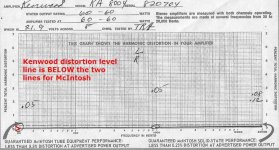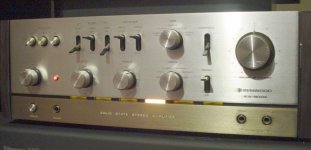1973 KA-8004 integrated amp with three push buttons for three sets of speakers, allowing the option of driving six speakers simultaneously. Only recently added third set and perplexed why so few amps offer this feature, including other amps of that era and newer designs as well. Kenwoods next amp, model 8006, had the conventional knob with maximum of 4 speakers: A, B, A & B, or C.
Seeking insight regarding enhanced design features (if any) the 8004 might incorporate to offer six speaker option, or did Kenwood throw caution to the winds for this particular model. 8004 lacks power output indicator or load warnings.
Graph is from 1975 McIntosh amp clinic. Kenwood trumped advertised McIntosh distortion levels. 8004 has never required service.
Seeking insight regarding enhanced design features (if any) the 8004 might incorporate to offer six speaker option, or did Kenwood throw caution to the winds for this particular model. 8004 lacks power output indicator or load warnings.
Graph is from 1975 McIntosh amp clinic. Kenwood trumped advertised McIntosh distortion levels. 8004 has never required service.
Attachments
Seeking insight regarding enhanced design features (if any) the 8004 might incorporate to offer six speaker option, or did Kenwood throw caution to the winds for this particular model.
A simple examination of the schematic makes it clear - it used special switching for the B+C speaker outputs - and all speakers were really required to be 8 ohms (if you wanted to run it at all loudly).
So A+B - speaker A (8 ohms), speaker B (8 ohms) in parallel - total 4 ohms.
A+C - Speaker A (8 ohms), speaker C (8 ohms) in parallel - total 4 ohms.
A+B+C - A (8 ohms), speaker B (8 ohms) and speaker C (8 ohms) in series (16 ohms) then in parallel with A - total 6.4 ohms.
So nothing particularly clever or complicated (and in fact many external speaker switching boxes do just the same), but it's rather limited and awkward.
It goes without saying that anything a single power amplifier can do must be via output switching or external wiring hook-ups which anyone who understands basic electrical laws can apply and juggle about with for the same result. Extra terminals with coded labels and switches just make that easier for someone who likes to frequently change the set-up.
However, the switch contacts are generally flimsy and far from ideal as speaker connectors. They are best eliminated completely and simple external connectors used, if good quality speaker connections mean anything to you.
However, the switch contacts are generally flimsy and far from ideal as speaker connectors. They are best eliminated completely and simple external connectors used, if good quality speaker connections mean anything to you.
Insight welcomed
Nicely done !! Schematic came with the amp, but even with the benefit of your input it was impossible for a novice to follow. Brief reference to the manual served to remind not to stack anything on top, but no recommendations for speaker loads, although all are 8ohm.
It can be difficult to perceive the difference between four and six speakers. The primary attraction is the option of various combinations and speaker comparison.
A simple examination of the schematic makes it clear - it used special switching for the B+C speaker outputs - and all speakers were really required to be 8 ohms (if you wanted to run it at all loudly).
So A+B - speaker A (8 ohms), speaker B (8 ohms) in parallel - total 4 ohms.
A+C - Speaker A (8 ohms), speaker C (8 ohms) in parallel - total 4 ohms.
A+B+C - A (8 ohms), speaker B (8 ohms) and speaker C (8 ohms) in series (16 ohms) then in parallel with A - total 6.4 ohms.
So nothing particularly clever or complicated (and in fact many external speaker switching boxes do just the same), but it's rather limited and awkward.
Nicely done !! Schematic came with the amp, but even with the benefit of your input it was impossible for a novice to follow. Brief reference to the manual served to remind not to stack anything on top, but no recommendations for speaker loads, although all are 8ohm.
It can be difficult to perceive the difference between four and six speakers. The primary attraction is the option of various combinations and speaker comparison.
It can be difficult to perceive the difference between four and six speakers. The primary attraction is the option of various combinations and speaker comparison.
As I mentioned above, you can buy external speaker switching boxes - and these put the speakers in series, and short out the unused ones (just as B+C in your example).
It's just a question of reversing your initial premise - you're not 'selecting' the speakers you want, you're actually 'de-selecting' the ones you don't want
It's a peculiar 'difference' to get your head round.
Hello,
Does any one has Kenwood KA8004 service manual, I have this amp to be refurbished and need to replace caps and other components. I am finding it very tedious to locate component based on Circuit Diagram which is available on net. I need PCB layout for the AMP as many components are replaced and I want to bring it to original spec, Service Manual will be of a great help.
Even I am suprised to see theree Speaker connections for such low wattage Amp. Never the less, have decided to refurbish the on.
Does anyone have Service Manual here.
Thanks,
Sachin
Does any one has Kenwood KA8004 service manual, I have this amp to be refurbished and need to replace caps and other components. I am finding it very tedious to locate component based on Circuit Diagram which is available on net. I need PCB layout for the AMP as many components are replaced and I want to bring it to original spec, Service Manual will be of a great help.
Even I am suprised to see theree Speaker connections for such low wattage Amp. Never the less, have decided to refurbish the on.
Does anyone have Service Manual here.
Thanks,
Sachin
- Status
- This old topic is closed. If you want to reopen this topic, contact a moderator using the "Report Post" button.
- Home
- Amplifiers
- Solid State
- Kenwood amp driving 6 speakers: Safe?

